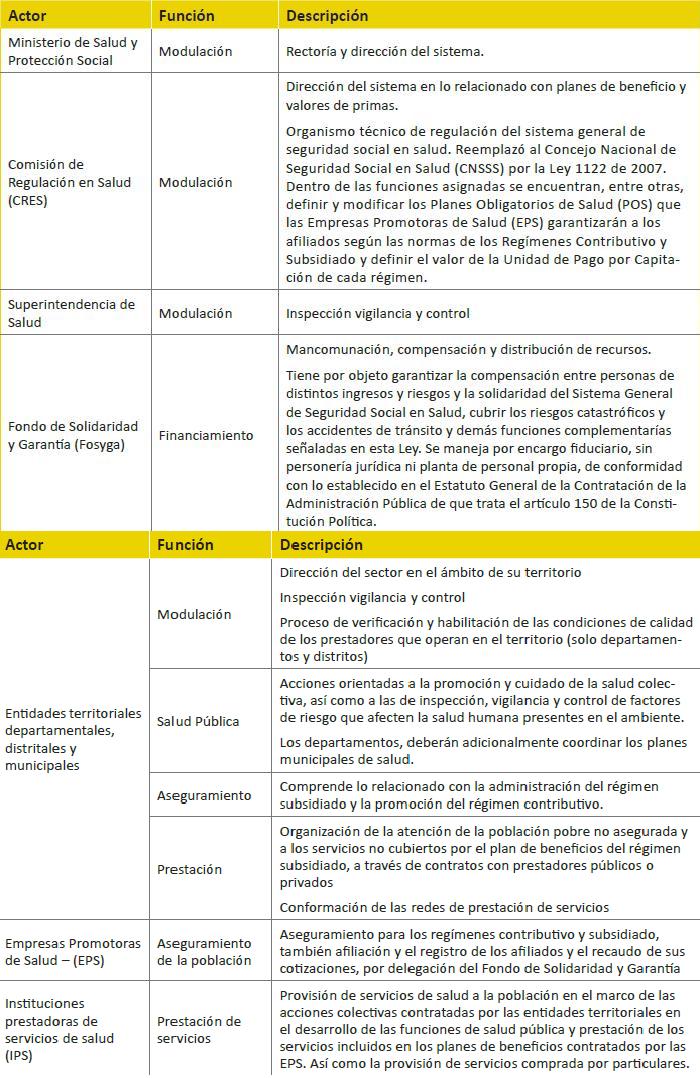You are here
Colombia
Bandeira:

Links de interesse:
Documentos de referência:
Informações gerais:
Região:
Post date:
O Sistema de Saúde:
The Colombian health system corresponds to a system organized as a public service, where the guarantee of access to services and financial protection of the population is given through social insurance.
The architecture of the Colombian health system points to a high specialization of the roles of its different actors, public-private participation in underwriting and maintenance and the regulated market, to achieve higher levels of efficiency and quality management.
Based on the theory of health systems, the Colombian responds largely to the model of structured pluralism (Londoño and Frenk, 1997), in which five clearly identifiable functions developed, seen from the current legislative framework are:
- Modulation: This function incorporates rectory, management, surveillance, inspection and control system. The rectory of the system, that is to say, the direction, orientation and conduction of the Health Sector is in charge of the Ministry of Health and Social Protection (MSPS), as indicated in art. 4 of Law 1,438 of 2011.
Contributing to the system within the framework of the decentralization of services and territories, the following organizations are on the guidelines dictated by the MSPS: a) The Commission for Health Regulation (CRES), in respect of benefit plans and higher values; and b) the departmental, district and municipal health entities. It is the responsibility of the departments, districts and municipalities to direct, coordinate and control the health sector and SGSSS in the territory of their jurisdiction, taking into account the national provisions on the subject.
- Financing: The financing model of the Colombian SGSSS was recognized by WHO as one of the most solidary in the world (WHO, 2000). The system mobilizes resources from primary sources (residences and companies), through contributions, and from secondary sources (resources of the Nation), to the Fondo de Solidaridad y Garantia (Fosyga), where a set of compensation rules and distribution that allows the obtaining of financing, preventive actions of public health and catastrophes.
Actions such as those of public health are financed with resources of the Nation and territories with specific destination.
- Public health. It includes actions that address collective health, intervention of health determinants, environmental sanitation, etc. With the implementation of Law 1438 of 2011 and the adoption of the strategy of primary health care, this component is beyond the scope of actions that fall within the health sector, to include also the interaction with all other sectors that have an influence on the health of the populations. Nonetheless, the MSPS, the departmental, district and municipal health divisions continue to be responsible for the development of this component.
- Assurance. It is oriented to individual health and is understood as the administration of financial risk, health risk management, articulation of services that guarantee effective access, quality assurance in the provision of health services and the representation of the affiliate before the provider and the other actors, without losing the autonomy of the user. It should be noted that insurance in the SGSSS incorporates a Mandatory Plan of Services: a set of explicit guarantees for the population; and that for its access and the guarantee of its performance, each affiliate is recognized by each health promoting entity (EPS) a per capita value, which is called the Capitation Payment Unit. EPS are the entities responsible for carrying out the non-delegable functions of the insurance for the contributory and subsidized schemes, as well as those of affiliation and the collection of their contributions, by delegation of the Solidarity and Guarantee Fund.
- Provision of health services. The provision or provision of health services to the Colombian population is carried out through different types of health service providers, public or private institutions that provide outpatient and hospital services, independent professionals, among others. The health service providers operate in a regulated market scenario, complying with the qualification standards established by the Obligatory System of Quality Assurance, and offer their services to any of the System payers. Table 1 presents in a synthetic way the functions in which the different actors of the system participate.

Source: Book 'Health Systems in South America: Challenges to Universality, Integrity and Equality'.
According to the study "Comparative analysis of the characteristics of health systems in the Americas" by Cinthia Granja Silva: The current Colombian challenge is to contextualize EPSs to the largest stakeholders, the population and physicians. Currently, the negotiation is done directly with the institutions providing health care and there is still a need to increase health coverage to citizens who are not included in any of the plans (SUAREZ; AVELLANEDA, 2004).
